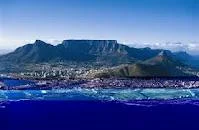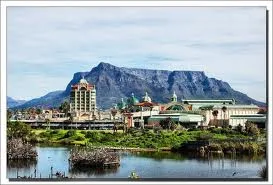Table Mountain is an icon of South Africa and the only natural site on the planet to have a constellation of stars that were given the same name - Mensa, which means "table".
Table Mountain is a flat-topped mountain forming a prominent landmark overlooking the city of Cape Town in South Africa. This is a significant tourist attraction, with many visitors using the cableway or hiking to the summit. Mount is part of the Table Mountain National Park.
Features Table Mountain seen from the main Head.The features Table Mountain lions are the level plateau approximately 3 kilometers (2 miles) from side to side, surrounded by steep cliffs. Plateau, flanked by Devil's Peak in the east and by Lion's Head to the west, forming a dramatic backdrop to Cape Town and its Table Bay harbor, and together with Signal Hill form a natural amphitheater of the City Bowl.
The highest point on Table Mountain is towards the eastern end of the plateau and is characterized by Maclear's Beacon, a stone Cairn built in 1865 by Sir Thomas Maclear for trigonometrical survey. It is 1086 meters (3563 feet) above sea level, about 19 meters (62 feet) higher than the cable station at the western end of the plateau.
The cliffs on the main plateau are split by Parks Platteklip ("Flat Stone Garden"), which provides easy and direct ascent to the summit and the route taken by Antonio de Saldanha on the first recorded ascent of the mountain in the year 1503.
Flat top of the mountain is often covered by orographic clouds, formed when the wind is directed onto the south eastern slopes of the mountain to the cooler air, where water condenses to form the fabric "table called" cloud. Legend attributes this phenomenon to a smoking contest between Satan and the local pirate named Van grabber. When the table cloth looks, it symbolizes the contest.
Table Mountain at the north end of the sandstone mountains that form the backbone of the Cape Peninsula. To the south of the main plateau is the bottom of the range called the Back Table. On the Atlantic coast of the peninsula, the range is known as the Twelve Apostles. This range continues southward to Cape Point.
Panorama from the top of Table Mountain. From left to right are Lion's Head seen, Signal Hill, Robben Island, Cape Town city center, Table Bay and Devil's Peak.Geology Cape Peninsula and Table Mountain Landsat image over SRTM Elevation. North to the left of the picture, and Table Mountain is in the foreground on the northern tip of the peninsula.
Table Mountain from the upper slopes of the mesa mountain Lion Head.The consists of Ordovician quartzitic sandstone, often referred to as the Table Mountain Sandstone (TMS), which is highly resistant to erosion and other forms characteristic steep gray cliffs. Below the sandstone is a layer of basalt flakes of mica, the weather is quite easy and therefore not easily visible. basement consists of folded and weight change late Precambrian Malmesbury shale, which have been intruded by Cape Granite. Bedrock is not nearly as resistant to weathering as TMS but significant outcrops of Cape Granite visible on the west side of Lion's Head.
flora
The main vegetation of the mountain is a unique and rich Cape fynbos, which is part of the Cape Floral Region protected areas. These areas are protected as a World Heritage Site, and an estimated 2200 plant species found on the mountain alone. Among these species are many types of Proteas.
Remaining indigenous forest patches remain in some but not on wet cliff face is more open on the town, where conditions are too dry and rough to the forest. The mountain is also suffering from a serious attack of foreign plants for over a century, with the worst invaders may be a cluster of pine trees. considerable effort has been made to eliminate alien plants.
fauna
The most common animals on the mountain is the dassie, or rock hyrax. They especially cluster around the upper cable station, near the area where tourists can discard or (illegally) the food supply. There are also hedgehogs, mongooses, snakes and turtles. Last lion was shot in the area around the year 1802.
Leopards hold on the mountain until probably the 1920's but are now locally extinct. Two smaller, secret, carnivorous night, which rooikat (Caracal) and vaalboskat (also called vaalkat or African Wild Cat) used on the mountain. rooikat continue to be seen on rare occasions by mountaineers vaalboskat but status is uncertain.
Himalayan tahrs, descendants tahrs fugitive who escaped from the Groote Schuur zoo in 1936, is used for the public at the top of the mountain less accessible. As an exotic species, they almost destroyed through eradication program initiated by the South African National Parks to make way for the reintroduction of indigenous klipspringers. Until recently there was also a small number of European fallow deer and sambar deer of Southeast Asia are particularly at Rhodes Memorial area but during the 1960's they can be found as far afield as Signal Hill. The beast may now have been eliminated or moved.
History
Table Mountain from Captain Cook's ship HMS Resolution by William Hodges (1772) De Villers reservoir, just to the left as the Bridle Path reaches the top of the original Back TableThe name given to the mountain by the first Khoi inhabitants kwaggo Hoeri '("sea mountain").
Prehistoric people first left evidence here of more than 600,000 years ago. This evidence of Early Stone Age hunter-gatherers found in a depression near the Cape of Good Hope. Middle Stone Age people (from 200,000 to 40,000 years ago) also left evidence of their lives on the Peninsula. Fossils from about 8000 BC shows that by that period the population of this region have developed bows and arrows which they use for hunting.
San (or Bushmen) hunter-gatherers relying on the beach for most of their food. This resulted in the naming of the Netherlands, Strandlopers (beach combers). About 2000 years ago Khoikhoi migrated from the north, displacing the San, by bringing their cattle and sheep herds. It was a Khoikhoi tribe dominant when Europeans sailed into Table Bay.
António de Saldanha was the first European who landed in Table Bay. He's a big mountain to climb in 1503 and named it 'Table Mountain'. Big cross that Portuguese navigator carved in the rock of Lion's Head is still traceable.
In 1796, during the British occupation of the Cape, Major-General Sir James Craig ordered three blockhouses to be built at Table Mountain: stronghold of the King, Duke of York's stronghold (later renamed Queen's stronghold), and the stronghold of the Prince of Wales. Two of them are in ruins today, but the stronghold of the King is still in good condition and is easily accessible from the Rhodes Memorial.
Between 1896, and 1907 five dams, the Woodhead, Hely-Hutchison, De Villiers, Alexandria and Victoria reservoirs, opened in Tables Return to Cape Town's water supply needs. A ropeway ride from Camps Bay via the cliff Kasteelspoort used to ferry materials and labor (the anchor points on the old station can still be seen). There is a steam locomotive preserved from this period are stored in the Museum of taps on the top of the mountain near the dam Hely-Hutchinson.
Been used to transport materials to the dam at the top of the mountain flat. water requirements of Cape Town has since far exceeded the capacity of the dam and they no longer become an important part of the water supply.
The mountain is a part of the new Cape Peninsula National Park in the 1990's. The park was renamed by the Table Mountain National Park in 1998.
Fires are common in the mountains. Recent major fire occurred in January 2006, destroying a large amount of vegetation and resulted in the death of tourists.
A charge of arson and murder were laid against innocent British people suspected of starting the blaze.
Cableway
Table Mountain Aerial Cable CarThe Table Mountain cableway [11] carrying passengers from the lower cable station on Tafelberg Road, about 302 m above sea level, to the plateau at the top of the mountain. Upper cable station offers views overlooking Cape Town, Table Bay and Robben Island in the north, and the Atlantic seaboard in the west and south.
Development cableway was first started in 1926, and the cableway was officially opened in 1929. In 1997, the cableway was extensively upgraded, and new cars were introduced carrying 65 instead of 25 passengers. The new cars provide a faster trip to the top, and rotate through 360 degrees during the ascent or descent, giving views of the city.
Upper cable station offers viewpoints, curio shops, restaurants and walking trails of various lengths.
Activities Hiking
Winter ascent of Table Mountain. Climbers set out on one of the popular trailsHiking on Table Mountain is popular among locals and tourists, and a number of tracks of varying difficulty are available. Because of the steep cliffs around the summit, direct ascents from the side of the city is limited.
Platteklip Gorge, a canyon leading the center of the main table, was immediately popular and direct ascent to the summit. Par for the course is approximately 2.5 hours, but carried out between 1-3 hours depending on one's fitness level.
a longer route to the top go through the Table Again, a lower area of Table Mountain south of the main plateau. From the South Suburbs, Garden Nursery Ravine and Skeleton route starts from Kirstenbosch National Botanical Garden. The route via Skeleton Gorge to Maclears Beacon known as Smuts Track in January Smuts memory, which is a sharp pedestrians. Bridle road, or Jeep Track, making the ascent more gradual ari Constantia Nek along the road that used to service the dam on the Back Table. There are many other roads in the popular walking area on the slopes below the mountain accessible from Constantia Nek, Cecilia Forest, Kirstenbosch, Newlands Forest and Rhodes Memorial.
On the Atlantic side, the most popular ascent is Kasteelspoort, a cliff overlooking Camps Bay, while the Pipe Track is a popular route with pedestrian level.
The Trails Hoerikwaggo are four hiking trails on Table Mountain between two to six days, which is operated by the National Parks of South Africa.
Area's original inhabitants, who Khoekhoen and San tribes called Table Mountain Hoerikwaggo - "sea mountain". Fourth Table Mountain hiking trails called the People's Trail, Table Mountain Trail, Orangekloof Hiking Trail Trail and Top Tips.
Rock climbing Rock climbing on Table Mountain is a very popular hobby. There are well-documented route many different levels of difficulty climbing the mountain face. The main climbs are located on the cliffs below the upper cable station. No run can be done here and only traditional climbing is permitted.
Commercial groups also offer abseiling from the upper cable station.
Caving Most important cave in the world occur in Table Mountain limestone but is unusual in having several large cave systems that have developed in the sandstone. The biggest is the Wynberg cave system, located in Table Back, not far from the Jeep Track, in the mountains overlooking Orange Kloof and Hout Bay.
"Mensa" constellation of Table Mountain is the only terrestrial feature to give the name of a constellation-Mensa, means table. Constellations are visible in the southern hemisphere, below Orion, around midnight in mid-July. It named by French astronomer Nicolas de Lacaille during his stay at the Cape in the mid-eighteenth century.
A7GV4VTJ9AGT






























